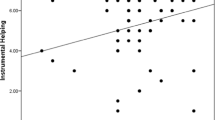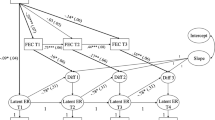Abstract
Emotion regulation is the earliest indicator of self-regulation and can affect the subsequent development of other self-regulation behaviors. Thus, understanding how children of immigrants develop emotional regulation is imperative as it has important implications for their life course. Using a nationally representative sample of children in 2001 from the Early Childhood Longitudinal Study – Birth Cohort (ECLS-B), the study investigates the relationship between family structures – both nuclear and extended family structures – and child’s emotional regulation for Mexican-origin children. The study finds that the influences of family structures on children’s emotion regulation across racial and ethnic groups differ. Specifically, for U.S.-born children of Mexican immigrant parents, residing in vertically extended family structures (i.e., with grandparents) is negatively associated with children’s emotion regulation whereas residing in horizontally extended family structures (i.e., with aunt or uncle) is positively associated with children’s emotion regulation. However, the significant relationships between family structures and children’s emotion regulation disappear when controlling for parental sensitivity towards children.
Similar content being viewed by others
References
Amato, P. R., & Keith, B. (1991). Parental divorce and the well-being of children: A meta-analysis. Psychological Bulletin, 110(1), 26–46.
Andreassen, C., & West, J. (2007). Measuring socioemotional functioning in a national birth cohort study. Infant Mental Health Journal, 28(6), 627–646.
Barnard, K. (1978). Nursing child assessment satellite training: Learning resource manual. Seattile: University of Washington, School of Nursing.
Beauchaine, T. P., Gatzke-Kopp, L., & Mead, H. K. (2007). Polyvagal theory and developmental psychopathology: Emotion dysregulation and conduct problems from preschool to adolescence. Biological Psychology, 74(2), 174–184.
Blair, C., Granger, D., & Razza, R. P. (2005). Cortisol reactivity is positively related to executive function in preschool children attending head start. Child Development, 76(3), 554–567.
Borjas, G. (1999). Heaven's door: Immigration policy and the American economy. Princeton: Princeton University Press.
Boyer, W. (2012). Cultural factors influencing preschoolers’ acquisition of self-regulation and emotion regulation. Journal of Research in Childhood Education, 26(2), 169–186.
Boyer, W. (2013). Getting back to the woods: Familial perspectives on culture and preschoolers’ acquisition of self-regulation and emotion regulation. Early Childhood Education Journal, 41(2), 153–159.
Bradley, B., DeFife, J. A., Guarnaccia, C., Phifer, J., Fani, N., Ressler, K. J., et al. (2011). Emotion dysregulation and negative affect: Association with psychiatric symptoms. Journal of Clinical Psychiatry, 72(5), 685–691.
Brandon, P. D. (2002). The living arrangements of children in immigrant families in the United States. International Migration Review, 36(2), 416–436.
Brown, S. L., Hook, J., & Glick, J. E. (2008). Generational differences in cohabitation and marriage in the US. Population Research and Policy Review, 27(5), 531–550.
Carlson, S. M., & Wang, T. S. (2007). Inhibitory control and emotion regulation in preschool children. Cognitive Development, 22(4), 489–510.
Casey, R. (1996). Emotional competence in children with externalizing and internalizing disorders. In M. Lewis & M. Sullivan (Eds.), Emotional development in atypical children (pp. 161–183). Mahwah: Lawrence Erlbaum.
Cauce, A., & Domenech Rodriguez, M. (2002). Latino families: Myths and realities. In K. Contreras & A. Neal-Barnett (Eds.), Latino children and families in the United States: Current research and future directions (pp. 3–25). Westport: Praceger.
Choi, K. H., & Seltzer, J. A. (2011). Race, ethnic, and nativity differences in the demographic significance of cohabitation in Women's lives. In California Center for Population Research working paper series. Los Angeles: UCLA.
Cole, P. M. (1986). Children’s spontaneous control of facial expressions. [article]. Child Development, 57(6), 1309–1321. doi:10.1111/1467-8624.ep7252163.
Cox, M. J., & Paley, B. (2003). Understanding Families as Systems. Current Directions in Psychological Science, 12(5), 193–196. doi:10.1111/1467-8721.01259.
Crosnoe, R., & Fuligni, A. J. (2012). Children from immigrant families: Introduction to the special section. Child Development, 83(5), 1471–1476.
Dollar, J. M., & Stifter, C. A. (2012). Temperamental surgency and emotion regulation as predictors of childhood social competence. Journal of Experimental Child Psychology, 112(2), 178–194.
Ennis, S., Rois-Vargas, M., & N. A. (2011). The Hispanic population: 2010 census briefs. Washington, DC: U.S. Census Bureau.
Fortuny, K., Hernandez, D. J., & Chaudry, A. (2010). Young children of immigrants: The leading edge of America's fugure. Washington, DC: The Urban Institute.
Fosco, G. M., & Grych, J. H. (2013). Capturing the family context of emotion regulation: A family systems model comparison approach. Journal of Family Issues, 34(4), 557–578.
Gordon, S. L. (1989). The socialization of children’s emotions: Emotional culture, competence, and exposure. In C. Saarni & P. Harris (Eds.), Children’s understanding of emotion (pp. 319–349). Cambridge: Cambridge University Press.
Gross, J., & Thompson, R. (2007). Emotion regulation: Conceptual foundations. In J. Gross (Ed.), The handbook of emotio regulation (pp. 3–24). New York: Guilford Press.
Hernandez, D. J. (2004). Demographic change and the life circumstances of immigrant families. Future of Children, 14(2), 17–47.
Jahromi, L. B., Putnam, S. P., & Stifter, C. A. (2004). Maternal regulation of infant reactivity from 2 to 6 months. Developmental Psychology, 40(4), 477–487. doi:10.1037/0012-1649.40.4.477.
Johnson, D. R., & Young, R. (2011). Toward best practices in analyzing datasets with missing data: Comparisons and recommendations. Journal of Marriage and Family, 73(5), 926–945.
Jonsson, S. H., & Rendall, M. S. (2004). The fertility contribution of Mexican immigration to the United States. Demography, 41(1), 129–150.
Kopp, C. B. (1989). Regulation of distress and negative emotions: A developmental view. Developmental Psychology, 25(3), 343–354.
Landale, N. S., Thomas, K. J. A., & van Hook, J. (2011). The living arrangements of children of immigrants. Future of Children, 21(1), 43–70.
Love, J. M., Kisker, E. E., Ross, C., Constantine, J., Boller, K., Chazan-Cohen, R., et al. (2005). The effectiveness of early head start for 3-year-old children and their parents: Lessons for policy and programs. Developmental Psychology, 41(6), 885–901.
Mesquita, B., & Albert, D. (2007). The cultural regulation of emotions. In J. J. Gross (Ed.), The handbook of emotion regulation (pp. 486–503). New York: Guilford Press.
Morgan, P. L., Farkas, G., Hillemeier, M. M., & MacZuga, S. (2009). Risk factors for learning-related behavior problems at 24 months of age: Population-based estimates. Journal of Abnormal Child Psychology, 37(3), 401–413.
Morris, A. S., Silk, J. S., Steinberg, L., Myers, S. S., & Robinson, L. R. (2007). The role of the family context in the development of emotion regulation. Social Development, 16(2), 361–388.
National Research Council and Institue of Medicine. (2000). From neutrons to neighborhoods: The science of early childhood development. Washington, DC: National Academy Press.
Portes, A., & Zhou, M. (1993). The new second generation: Segmented assimilation and its variants. The Annals of the American Academy of Political and Social Science, 530(1), 74–96. doi:10.1177/0002716293530001006.
Roberton, T., Daffern, M., & Bucks, R. S. (2012). Emotion regulation and aggression. Aggression and Violent Behavior, 17(1), 72–82.
Shaffer, A., Suveg, C., Thomassin, K., & Bradbury, L. L. (2012). Emotion socialization in the context of family risks: Links to child emotion regulation. Journal of Child and Family Studies, 21(6), 917–924.
Shonkoff, J. P., & Phillips, D. A. (2000). From neurons to neighborhoods: The science of early childhood development. Washington, DC: National Academy Press.
Stifter, C. A., & Fox, N. A. (1990). Infant reactivity: Physiological correlates of newborn and 5-month temperament. Developmental Psychology, 26(4), 582–588.
Taylor, Z. E., Larsen-Rife, D., Conger, R. D., & Widaman, K. F. (2012). Familism, Interparental conflict, and parenting in Mexican-origin families: A cultural-contextual framework. Journal of Marriage and Family, 74(2), 312–327.
Thompson, R. A. (1991). Emotional regulation and emotional development. Educational Psychological Review, 3(4), 269–307.
Thompson, R. A. (1994). Emotion regulation: A theme in search of definition. Monographs of the Society for Research in Child Development, 59(2–3), 25–52. doi:10.2307/1166137.
Thompson, R. A., & Meyer, S. (2007). Socialization of emotion regulation in the family. In J. J. Gross (Ed.), The handbook of emotion regulation (pp. 249–268). New York: Guildford Press.
Turney, K., & Kao, G. (2009). Pre-kindergarten child care and behavioral outcomes among children of immigrants. Early Child Research Quarterly, 24(4), 432–444.
Young, R., & Johnson, D. (2013). Methods for handling missing secondary respondent data. Journal of Marriage and Family, 75(1), 221–234.
Zelazo, P., & Cunningham, W. (2007). Executive function: Mechanisms underlying emotion regulation. In J. Gross (Ed.), The handbook of emotion regulation (pp. 135–158). New York: Guilford Press.
Acknowledgements
This work was supported by the Eunice Kennedy Shriver National Institute of Child Health and Human Development (NICHD) under Grant R24 HD041025-11 and Grant T-32HD007514.
Author information
Authors and Affiliations
Corresponding author
Rights and permissions
About this article
Cite this article
Noah, A.J. Understanding the Relationships between Diverse Family Structures and the Development of Emotion Regulation of Mexican-Origin Children: Population-Based Estimates. Child Ind Res 11, 1515–1530 (2018). https://doi.org/10.1007/s12187-017-9482-7
Accepted:
Published:
Issue Date:
DOI: https://doi.org/10.1007/s12187-017-9482-7




